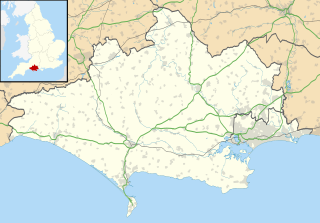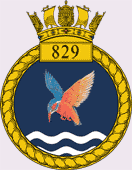
The Royal Naval Air Service (RNAS) was the air arm of the Royal Navy, under the direction of the Admiralty's Air Department, and existed formally from 1 July 1914 to 1 April 1918, when it was merged with the British Army's Royal Flying Corps to form the Royal Air Force, the world's first independent air force.

The Sopwith Pup was a British single-seater biplane fighter aircraft built by the Sopwith Aviation Company. It entered service with the Royal Flying Corps and the Royal Naval Air Service in the autumn of 1916. With pleasant flying characteristics and good manoeuvrability, the aircraft proved very successful. The Pup was eventually outclassed by newer German fighters, but it was not completely replaced on the Western Front until the end of 1917. Remaining Pups were relegated to Home Defence and training units. The Pup's docile flying characteristics also made it ideal for use in aircraft carrier deck landing and takeoff experiments.

Royal Naval Air Station Yeovilton, or RNAS Yeovilton, is an airfield of the Royal Navy and British Army, sited a few miles north of Yeovil, Somerset. It is one of two active Fleet Air Arm bases and is currently home to the Royal Navy Wildcat HMA2 and Army Air Corps Wildcat AH1 helicopters as well as the Royal Navy's Commando Helicopter Force Merlin HCi3/3A/4 and Wildcat AH1 helicopters.
RNAS Culham was a Royal Naval Air Station (RNAS) near Culham, Oxfordshire. It opened in 1944 as an Aircraft Receipt and Despatch Unit for the Royal Navy.

Royal Naval Air Station Culdrose is a Royal Navy airbase near Helston on the Lizard Peninsula of Cornwall UK, and is the largest helicopter base in Europe. Its main role is serving the Fleet Air Arm's front line Merlin helicopter squadrons.

RNAS Portland was an air station of the Royal Navy, situated at the Isle of Portland, Dorset, England. It was established in 1917 on the western edge of Portland Harbour as HMS Sarepta. From 1959 the station shared the name HMS Osprey, the anti-submarine establishment based at Portland, with helicopters used for research and development in anti-submarine techniques. RNAS Portland remained operational until 1999.
RNAS Calshot was a First World War Royal Navy air station for seaplanes and flying boats, mainly operating as an experimental and training station, but also providing anti-submarine and convoy protection patrols.

Mobile Operational Naval Air Bases (MONABs) were a series of mobile units first formed in 1944 to provide logistical support to the Fleet Air Arm aircraft of the Royal Navy's British Pacific Fleet towards the end of World War II.
Five ships and a number of shore establishments of the Royal Navy have borne the name HMS Daedalus, after the mythical Daedalus:

702 Naval Air Squadron was a naval squadron of the Royal Navy's Fleet Air Arm. It was based at RNAS Yeovilton in Somerset. As a training Squadron it trained all ground and air crew for the sister front-line maritime Lynx squadron, 815 NAS

815 Naval Air Squadron is a squadron of the Fleet Air Arm, part of the Royal Navy, based at RNAS Yeovilton in Somerset; it is the Navy's front line Wildcat Naval Air Squadron. It comprises AgustaWestland Wildcat HMA.2 helicopters and is the largest helicopter squadron in western Europe.

HMS Nabberley was a Royal Navy Mobile Naval Operating Air Base (MONAB) at the Royal Australian Air Force (RAAF) base RAAF Bankstown at Bankstown, New South Wales, Australia. HMS Nabberley was also known as MONAB II and Royal Naval Air Station (RNAS) Bankstown.

829 Naval Air Squadron was a squadron of the Royal Navy Fleet Air Arm. Before it was decommissioned in March 2018, it operated the AgustaWestland Merlin HM2 helicopter.

814 Naval Air Squadron or 814 NAS, nicknamed the Flying Tigers, is a squadron of the Royal Navy Fleet Air Arm. It is currently equipped with the AgustaWestland Merlin HM2 anti-submarine warfare helicopter and is based at Royal Naval Air Station (RNAS) Culdrose in Cornwall. The squadron was formed in December 1938 and has been disbanded and reformed several times.
Five ships and a shore establishment of the Royal Navy have borne the name HMS Osprey, after the bird of prey the Osprey:

Royal Naval Cemetery is a cemetery on the Isle of Portland, Dorset, England. The site overlooks Portland Harbour, and is found below the main entrance to the Verne Citadel. As the name suggests, the graveyard holds deceased servicemen and officers of Portland's Royal Navy which was stationed at the island until 1995. The cemetery holds 140 identified casualties in total to date, and is owned by the Ministry of Defence.

HMS Osprey was an anti-submarine training establishment located at the Isle of Portland, Dorset, England. It was active between 1924 and 1941, and again from 1946 to 1995. The helicopter station RNAS Portland shared the same name from 1959 and closed in 1999.















